2.13 Tree’s Shade
Figure 2.13: The left graph shows that big, deciduous trees (filled circles) shade a lot of the ground below them (after Shimano 1997). The crown projection area, simply the shaded area beneath a tree at high noon, beneath conifers (open squares) never gets as large. The right plot shows another study of how the width of an open-grown tree’s crown (diameter) varies with the width of its trunk (data from Smith et al. 1992 and Krajicek et al. 1961). Trees from the Food Lion parking lot (Figure 2.12) are not living up to their potential.
How much space can a shade tree shade? These basic physical measurements on trees indicate trees’ natural potential for shading parking lots. The left graph in Figure 2.13 comes from a 1966 study of temperate forests in central Japan. The deciduous tree data are from 247 individuals of six species including a beech, Fagus crenata, and an oak, Quercus crispula, and the conifer data come from 596 individuals from six species. At the high end are some really big trees — 4-foot diameter — much, much bigger than the ones in my photo of the parking lot of a Durham grocery store (Figure 2.12).[39]
The graph at right shows data for trees grown alone, with no competition between trees for sunlight, meaning they can grow as large as possible.[40] Trees experiencing such competition grow taller and narrower, providing less shade, but competition is the least of a parking lot tree’s problems. Assuming that trees are trees everywhere, I’ve combined data on oaks from a study in Austria and data for several pine species that are important for southeastern U.S. forests.[41] This figure includes trees closer in size to my parking lot trees.
Certainly, if one hopes to shade parking lots, one might not choose a loblolly pine. Old trees of this species have the shape of a big tall stick with a cotton ball at top, at least the ones remaining after all their neighbors get chopped down. Such a shape provides very little shade. Furthermore, loblolly pines drop their needles during summer droughts, and big old branches drop from these tall heights, which would do a nasty job on someone’s expensive sports car. The resulting lawsuit alone, from the business owner’s perspective, would wipe out any environmental benefit. In any event, even though loblolly pines grow fast and survive well in their native southeastern U.S. environment, other native tree species provide much more shade.
Do the Food Lion parking lot trees live up to their potential? I measured the first four trees (Bradford flowering pears) by the shopping cart in that photo,[42] obtaining an average diameter at breast height (DBH) of 24.5 cm and a crown width of 3.7 m, which gives a calculated projection area around 11.5 m2. Granted, my DBH measures weren’t quite at breast height because they branched at a lower height, but their averaged datum point shows they provide relatively little shade for their size.[43]
————————————-
[39]Tree data for crown projection area is given by Shimano (1997), who cites an inaccessible paper by Tatewaki et al. from 1966 concerning temperate forests in central Japan.
[40]These two crown size graphs seem to disagree, but the lack of competition in the right plot explains the difference. For example, look at a tree of 75 DBH. The Shimano (1997) data suggest a crown projection of, say, 100 m2, but the other studies suggest a diameter of around 15 m. Since the area is (π/4)D2, the latter crown projection area ought to be about 175 m2. Those numbers seem quite different, meaning trees without competition spread out a lot.
[41]Hasenauer (1997) looked at tree shape in Austria, and Smith et al. (1992) looked at pine species relevant to the southeastern United States.
[42]Two of these trees were cut down shortly after I took the measurements; I hope no cause and effect was in play.
[43]The data point plotting the Food Lion parking lot trees have a dot inside the circle; that dot is a different data point, not the parking lot trees.
